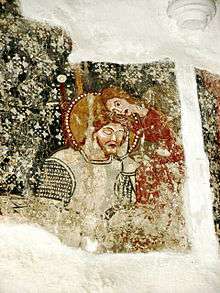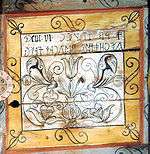Unitarian Church of Transylvania
| Unitarian Church of Transylvania | |
|---|---|
|
Logo of the Unitarian Church of Transylvania | |
| Classification | Protestant |
| Orientation | Unitarianism |
| Theology | Summa Universae Theologiae Christianae secundum Unitarios |
| Polity | quasi-episcopal |
| Bishop | Rev. Ferenc Bálint Benczédi |
| Associations | International Council of Unitarians and Universalists, European Liberal Protestant Network |
| Region | Transylvania |
| Origin | 1568 |
| Secondary schools | two |
| Official website | www.unitarius.org |
The Unitarian Church of Transylvania (Hungarian: Erdélyi Unitárius Egyház; Romanian: Biserica Unitariană din Transilvania) is a church of the Unitarian denomination, based in the city of Cluj, Transylvania, Romania. Founded in 1568 in the Principality of Transylvania, it has a majority-Hungarian following, and is one of the 18 religious confessions given official recognition by the Romanian state.
The Transylvanian and Hungarian Unitarians represent the only branch of Unitarianism not to have adopted a congregationalist polity, and remains quasi-episcopal; the Irish Non-subscribing Presbyterian Church, a distinct body closely related to Unitarianism, has a presbyterian structure.[1] The Unitarian Church of Transylvania is administrated by a Bishop and two Curators-General, being divided into five Archpriestships.[2] Since March 2009, its Bishop is Rev. Ferenc Bálint Benczédi. The Church, which uses Hungarian as the liturgical language, also endorses and teaches a catechism.[1]
Together with the Calvinist Reformed Church and the two Lutheran churches of Romania (the Evangelical Lutheran Church and the Evangelical Church of Augustan Confession), the Unitarian community runs the Protestant Theological Institute of Cluj, wherein Unitarianism is represented by a distinct section. In addition, it has two high school-level theological educational institutions.[2]
Demographics
.png)
According to the results of the 2002 census, there are 66,846 Romanian citizens of the Unitarian faith (0.3% of the total population).[3] Church officials place the number of believers at 80,000-100,000.[2] Of the total Hungarian minority, Unitarians represent 4.55%, being the third denominational group after members of the Reformed Church in Romania (47.10%) and Roman Catholics (41.20%).[4] Since 1700, the Unitarian Church has had 125 parishes — in 2006, there were 110 Unitarian priests and 141 places of worship in Romania.[2]
The vast majority of church adherents live in Transylvania, mostly between Sighişoara (Segesvár) and Odorheiu Secuiesc (Székelyudvarhely), more or less around Dârjiu (Székelyderzs). The Unitarian church is especially strong in Dârjiu, Atid (Etéd), Cristuru Secuiesc (Székelykeresztúr), Feliceni (Felsőboldogfalva), Inlăceni (Énlaka), and Mugeni (Bögöz), where Unitarians make up a large majority of the population. All of these localities are situated in the southwestern corner of Harghita County, except for Sighişoara which is located immediately outside of that area in the Southeastern corner of Mureş County.
History

The Unitarian Church was first recognized by the Edict of Torda, issued by the Transylvanian Diet under Prince John II Sigismund Zápolya (January 1568),[5] and was first led by Ferenc Dávid (a former Calvinist bishop, who had begun preaching the new doctrine in 1566). Early on, the Unitarian Church had notable successes: it included 425 parishes, made use of the monumental St. Michael's Church in Cluj-Napoca,[2] and attracted members of the eastern Transylvanian Székely community in large numbers.[5]
The Church attracted suspicion from all other established religions, Roman Catholic as well as Protestant, with both camps deeming it heretical.[5] After Dávid's imprisonment and 1579 death in custody, the institution entered a period of decline.[2][5] The church in Transylvania received many refugees following the expulsion of the Socinian Polish Brethren from Poland on July 20, 1658 and maintained contact with the dispersed communities of Polish Brethren in the Netherlands and Lithuania. Andrzej Wiszowaty Jr., great-great grandson of Fausto Sozzini, was one of the Polish exiles who taught at the Unitarian College in Cluj-Napoca, in the period in the 1730s when the church was reorganized and strengthened by Mihály Lombard de Szentábrahám, author of the church's official statement of faith, the Summa Universae Theologiae Christianae secundum Unitarios.
Following the Union of Transylvania with Romania at the end of World War I, Unitarian congregations were established in regions of the Old Kingdom: the first Unitarian church in Bucharest was founded in 1933 (its building was later demolished).[2]
American and British Unitarians became aware of the survival of the Unitarian Church in Transylvania following the visit of Alexander Farkas to Pennsylvania in 1831 and publication of his Account of the Unitarians of Transylvania, which was communicated in Latin to the Secretary of the British and Foreign Unitarian Association and published in the The Unitarian advocate and religious miscellany in 1832. On 5 June 1899 the American Unitarian Association sent a letter to Bishop Jozsef Ferencz of the Transylvanian Unitarian Church inviting the leaders of the church to the first International Association for Religious Freedom (IARF) conference in 1900. With the exception of 1920, Transylvanian Unitarian leaders have been present at all IARF congresses, and, in May 1975, Communist authorities allowed it to welcome the IARF's Executive Committee in the city of Cluj-Napoca.[6] In 1994, the IARF European Conference was held in the same location.[6] The Transylvanian Unitarian Church is also a founding member of the International Council of Unitarians and Universalists.
Social Issues
The church allows both men and women to be ordained as ministers. In 2016, the deputy bishop announced his support for same-sex marriage.[7]
Churches
The locality of Dârjiu is home to a 13th-century fortified church, later reformed as Unitarian, which is on UNESCO's World Heritage List. Murals, dating back to the Roman Catholic period, show King Ladislaus I of Hungary's legend: Cumans broke into the Kingdom of Hungary; Duke Ladislaus, along with his cousin King Solomon, rode against them and freed a girl believed to be daughter of a Hungarian nobleman from a Cuman's hands (although she did not support this act). Further murals in the region are to be found at Unitarian churches in Mugeni, Crăciunel, and smaller ones in Rugăneşti and Cristuru Secuiesc.
-
The Unitarian Church in Braşov
-

Ceiling of the Unitarian Church in Inlăceni, with a statement rendered in Old Hungarian script
-

The Unitarian Church in Şimoneşti
See also
References
- 1 2 Paul F. Bradshaw, The New SCM Dictionary of Liturgy and Worship, SCM-Canterbury Press Ltd, London, 2002, p.460. ISBN 0-334-02883-3
- 1 2 3 4 5 6 7 (Romanian) Marius Vasileanu, "Cultele din România: Biserica Unitariană", in Adevărul, May 25, 2006 (hosted by Hotnews.ro); retrieved July 27, 2007
- ↑ (Romanian) Recensământ 2002. Rezultate: Populaţia după religie la recensământul din 2002 Archived March 25, 2008, at the Wayback Machine.; retrieved July 27, 2007
- ↑ Anna Fenyvesi, Hungarian Language Contact Outside Hungary: Studies on Hungarian as a Minority Language, John Benjamins, Amsterdam/Philadelphia, 2005, p.141. ISBN 90-272-1858-7
- 1 2 3 4 Earl A. Pope, "Protestantism in Romania", in Sabrina Petra Ramet (ed.), Protestantism and Politics in Eastern Europe and Russia: The Communist and Postcommunist Eras, Duke University Press, Durham, 1992, p.160. ISBN 0-8223-1241-7
- 1 2 Árpád Szabó, Molnár B. Lehel, "Role of the Unitarian Church of Transylvania (Romania)", in Centennial Reflections: International Association for Religious Freedom, 1900-2000, Assen, 2001, p.107-111. ISBN 90-232-3685-8
- ↑ "Unitarian leader takes Equal Marriage stand in Romania". UUA International. 2016-02-09. Retrieved 2016-05-29.



